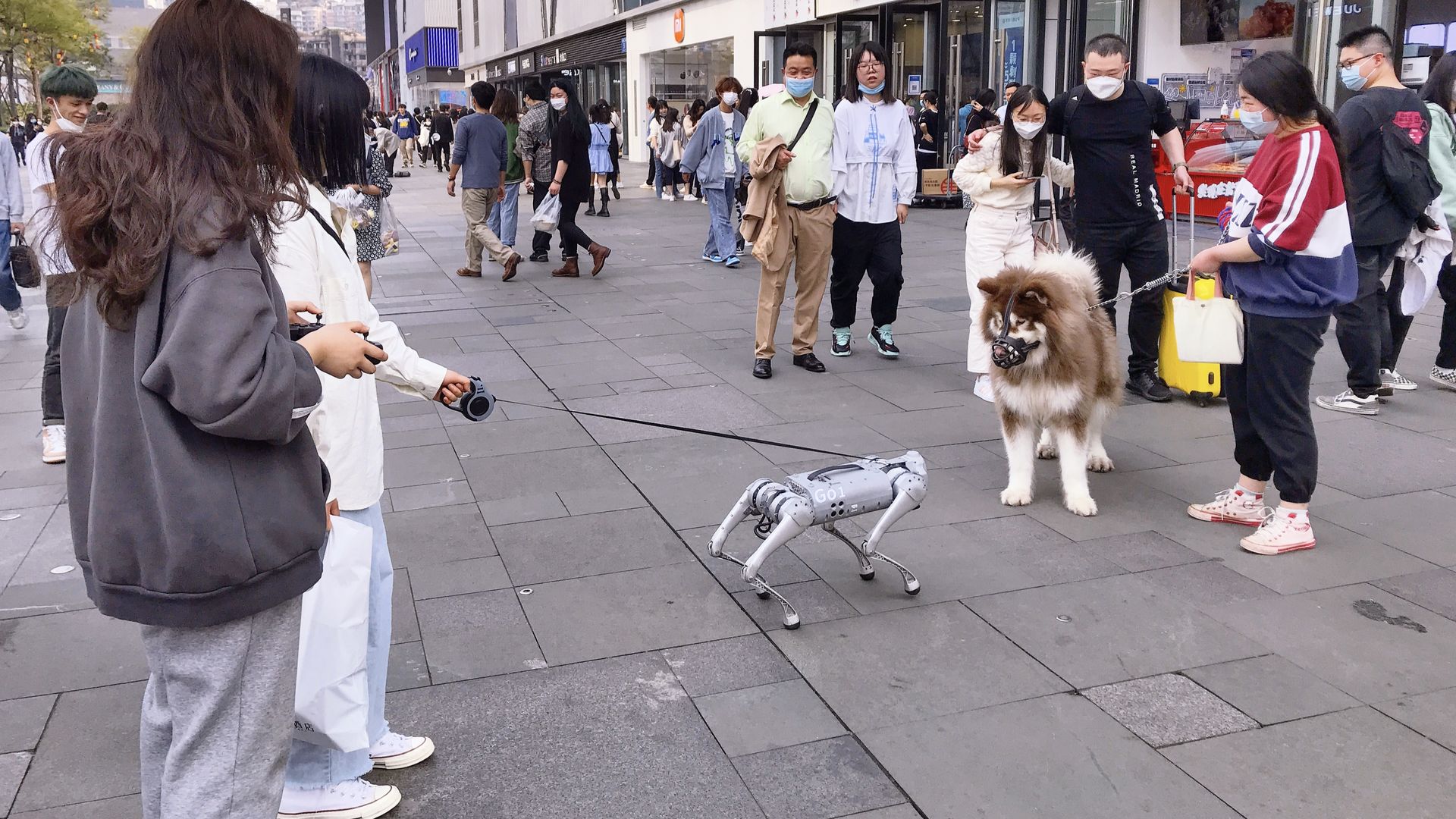| | | | | | | Presented By SoftBank Group | | | | Axios What's Next | | By Jennifer A. Kingson and Joann Muller ·Mar 15, 2022 | | Today is March 15 — the Ides of March. - The original imprecation to "beware" stems from the murder of Julius Caesar in 44 B.C., but Smithsonian Magazine has a handy list of other bad things that happened on this date.
- Did you know? Mask requirements on trains, planes and automobiles will expire on April 18.
Today's Smart Brevity count: 1,075 words ... 4 minutes. | | | | | | 1 big thing: Proposed safety rules give short shrift to women drivers |  | | | Illustration: Sarah Grillo/Axios | | | | Significant updates proposed to the federal government's flagship 5-Star Safety Ratings program do nothing to address the higher risk faced by female drivers, Joann Muller writes. Why it matters: Women face a higher risk than men of being seriously injured or killed in a crash — but most vehicle safety systems are tested using male crash test dummies. - Designing safety technologies to protect "the average male" leaves everyone else more vulnerable, safety advocates say.
Driving the news: The updates suggested by the National Highway Traffic Safety Administration (NHTSA) lean heavily on new driver-assistance technologies to try to make automobiles safer. Among the proposals: - Institute more stringent testing of NHTSA-recommended technologies, and of four new ones: lane-keeping support, pedestrian automatic emergency braking, blind spot detection and blind spot intervention.
- Potentially add technologies related to driver distraction, alcohol detection and driver monitoring systems, among others.
- Consider a new crash avoidance rating for driver-assistance technologies that could be displayed on the car's window sticker.
Yes, but: The proposed updates don't address the existing gender gap in vehicle safety testing, says former Rep. Susan Molinari, co-chair of a safety coalition called Verity (Vehicle Equity Rules in Transportation) Now. - "Until we require up-to-date female dummies in all crash tests, as the rule proposes to do for men, the U.S. government is sending a signal that it doesn't believe women's lives are as important as men's," Molinari said in a statement.
The other side: A NHTSA spokesperson says its 5-Star Safety Ratings system — also known as the New Car Assessment Program — has improved safety for all vehicle occupants and the regulations "appear to have also significantly reduced gender disparity in crash outcomes." Where it stands: NHTSA has a 60-day comment period on the proposed rules. Read the full story |     | | | | | | 2. Get a (soft) grip |  | | | Demo of a soft robotic hand gripper at the International Robot Exhibition in Tokyo last week. Photo: Kiyoshi Ota/Bloomberg via Getty Images | | | | Soft robotic grippers were "a laboratory curiosity" until a few years ago, but now they're "breaking into the real world," according to the American Society of Mechanical Engineers (ASME), Jennifer A. Kingson writes. Why it matters: These handlike grippers have manifold industrial uses that make them much better suited to delicate items than their hard-shelled equivalents. - Check out this video of Soft Robotics' mGrip gripper picking up marshmallow Peeps.
- "It's very difficult to handle these soft, delicate Peeps," says Randall Copeland, SVP of operations for Just Born, the maker of the chicks. Before the mGrip, "the only thing we found that could do it successfully was the human hand."
The bottom line: Soft grippers are "an attractive option for warehouses, food distributors, and factories with a high mix of products," ASME says, as they can move fragile objects that hard grippers would crush — like glass and baked goods. - "Because many soft grippers conform to objects, they are breathtakingly fast when it comes to picking up unstructured items from a line or bin, since they don't need to spend time calculating and managing a precise approach to each object," ASME says.
Share this story |     | | | | | | 3. Carbon dioxide emissions hit record high last year |  Reproduced from IEA; Chart: Axios Visuals The world's energy-related CO2 emissions reached an all-time high in 2021, according to new data released by the International Energy Agency, Andrew Freedman writes in Axios Generate. Why it matters: The emissions rebound after the COVID-related economic downturn is another sign that the global economic recovery has not been a "green" or sustainable one. Between the lines: Global energy-related CO2 emissions increased by 6% in 2021 to reach 36.3 billion tonnes, which was the highest level on record. - The year-to-year increase from 2020 to 2021 was the largest on record in absolute terms, the IEA found.
- The main culprit, according to the IEA, was the increased reliance on coal-fired power plants.
- The coal binge was largely driven by market conditions, including high natural gas prices.
Of note: When combined with data on methane emissions and other planet-warming gases, the analysis shows that overall greenhouse gas emissions from energy combustion and industrial processes hit their highest level on record in 2021. Share this story |     | | | | | | A message from SoftBank Group | | Accelerating human progress through technology | | |  | | | | At SoftBank Group, we invest in companies that accelerate human progress through technology. That's why we're proud to support the Smithsonian's FUTURES exhibit, which challenges us to envision how technology can enable a more empowered, connected world. | | | | | | 4. Tech's state-by-state privacy play |  | | | Illustration: Shoshana Gordon/Axios | | | | The tech industry is lobbying statehouses across the country to pass privacy bills that critics call weak, Margaret Harding McGill writes in Axios Login. Why it matters: Most tech firms would prefer a nationwide law, but since Congress hasn't budged on the issue, the industry is now seeking to preempt states from approving tougher privacy rules like California's. - "The states are where this conversation has happened," Tom Foulkes, senior director of state advocacy for software industry trade group BSA, told Axios. "Absent action by Congress, the states will act, and that's being proven every single day, especially here in 2022."
What's happening: Utah lawmakers considered and passed a state privacy bill in less than two weeks, and it's now awaiting the governor's signature. - Utah would become the fourth state with a privacy law, following Colorado, Virginia and California.
- A bill similar to the Utah measure is under consideration in Iowa, and other states, including Tennessee and Maryland, are also weighing privacy bills.
The intrigue: Consumer advocates say industry groups TechNet and the State Privacy and Security Coalition (SPSC) are pushing weak privacy bills in states while Congress dithers. - SPSC describes itself as a coalition of leading tech, telecom, media and retail companies. Members include AT&T, Apple, Google, Amazon and Meta.
- "I really want to be upfront about this and my hope that a Utah model could be copied in other states," Anton van Seventer, counsel to SPSC and a DLA Piper attorney, said during a Utah hearing on the bill.
- "It could serve as the most updated and streamlined model for state privacy legislation in the U.S. today."
Read the full story |     | | | | | | 5. Who's a good robot? |  | | | A robot dog goes for a walk in Chengdu, China. Photo: Gao Han/VCG via Getty Images) | | | | Robot dogs are gaining popularity as household companions in China, thanks to "two of China's burgeoning loves: pets and technology," according to Agence France-Presse. - One "breed," the AlphaDog, uses sensors and artificial intelligence technology to "hear" and "see" its environment — and can go almost 9 miles per hour and "spin on the spot like an excited puppy," per AFP.
- "Future software updates will include the dog 'barking' — and beyond that, even add human voices to allow conversations between pet and owner."
Here in the U.S., there have been various efforts to popularize robotic pets — the aibo, which looks more doglike than the AlphaDog, comes to mind — but the market has primarily been aimed at children or adults with dementia, rather than the young adults who are adopting robo-dogs in China. - Would you be interested in owning a robotic dog or cat? Send us your thoughts at whatsnext@axios.com.
Photo: Gao Han/VCG via Getty Images |     | | | | | | A message from SoftBank Group | | Creating a more empowered, connected future | | |  | | | | SoftBank Group — a global investor in AI and transformative technology — is proud to support the Smithsonian's FUTURES exhibit, at the Arts + Industries Building through July 6. Come experience this interactive, cutting-edge technology journey, and be part of creating a better future. | | | | Was this email forwarded to you? Get your daily dose of What's Next magic by signing up for our free newsletter here. |  | It's called Smart Brevity®. Over 200 orgs use it — in a tool called Axios HQ — to drive productivity with clearer workplace communications. | | | | | | Axios thanks our partners for supporting our newsletters. If you're interested in advertising, learn more here.
Sponsorship has no influence on editorial content. Axios, 3100 Clarendon Blvd, Suite 1300, Arlington VA 22201 | | | You received this email because you signed up for newsletters from Axios.
Change your preferences or unsubscribe here. | | | Was this email forwarded to you?
Sign up now to get Axios in your inbox. | | | | Follow Axios on social media:    | | | | | |











No comments:
Post a Comment